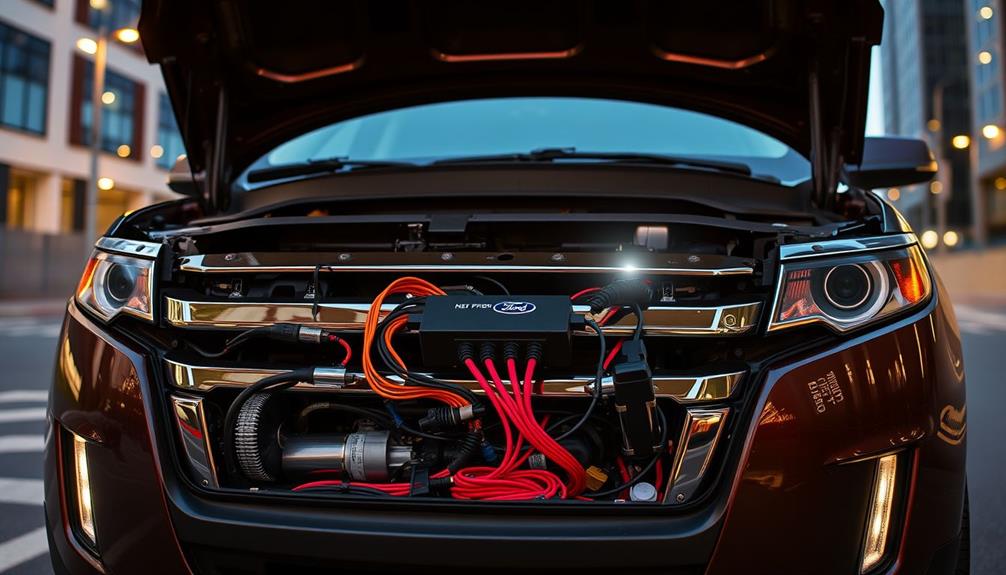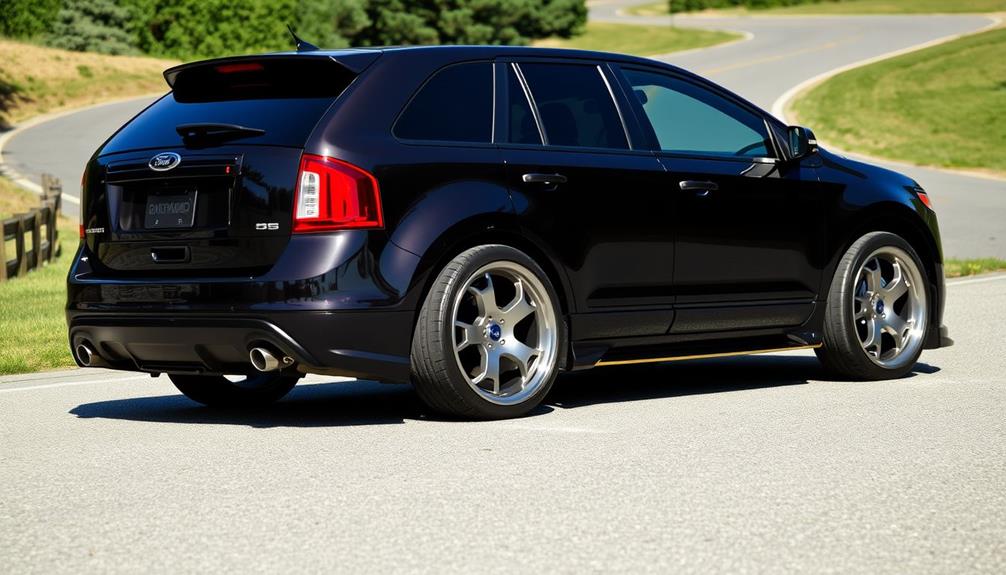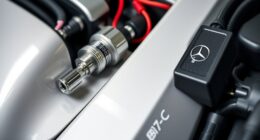Tuning your 2013 Ford Edge can dramatically boost its power and efficiency. Start with performance chips to enhance throttle response and engine output. Upgrading your air intake and exhaust systems improves airflow, which helps your turbo perform better. A handheld SCT device can provide significant gains—up to 46 horsepower and 77 lb-ft torque. Don't overlook adjustable suspension and lightweight wheels to improve handling dynamics. With the right tuning, you can also achieve better fuel economy, potentially saving you up to 4 mpg. Stick around to discover more about optimizing your Edge's performance and enhancing your driving experience!
Key Takeaways
- Tuning the 2013 Ford Edge can enhance power output by up to 46 WHP and improve torque by 77 WTQ using a handheld SCT device.
- Performance chips and ECU tuning optimize fuel efficiency, potentially saving up to 4 mpg while enhancing engine responsiveness.
- Upgrades like a performance air intake and downpipe alleviate airflow bottlenecks, significantly boosting engine performance and throttle response.
- Adjustable suspension and brake upgrades improve handling and stopping power, making the Edge more enjoyable to drive in various conditions.
- Community insights and resources can guide effective tuning strategies, balancing performance enhancements with practical driving needs.
Engine Specifications Overview
The 2013 Ford Edge boasts a powerful 2.0L EcoBoost inline 4 engine, delivering an impressive 240-250 horsepower. This engine's design isn't only budget-friendly but also tunable, making it a great choice for those looking to enhance performance.
With 16 lbs. of boost, this EcoBoost engine has the potential for high performance, especially when you consider an ECU tune.
You'll appreciate the torque efficiency that this engine offers across a wide RPM range, which greatly enhances drivability and responsiveness. Originally engineered for the lighter Ford Focus, the 2.0L EcoBoost in the Edge proves its versatility in various driving conditions.
To maximize performance, you might want to look into upgrading the air intake system. This can lead to better airflow, improving throttle response and overall engine efficiency.
If you take the time to explore extensive modifications, you'll find that considerable power gains are well within reach. By focusing on these engine specifications and tuning options, you'll reveal the full potential of your 2013 Ford Edge, making your driving experience even more enjoyable.
Essential Modifications for Performance

To get the most out of your 2013 Ford Edge, focusing on essential modifications can make a world of difference in performance. Start with performance chips, like those from SCT, which can enhance your throttle response and overall engine output for around $600. Next, consider upgrading your downpipe to alleviate air flow bottlenecks, vital for maximizing engine performance.
Another effective modification is installing a methanol injection system, which not only boosts power but also leads to improved fuel cleanliness, with costs ranging from $800 to $1500. Don't overlook the importance of adjustable suspension and weight reduction; these can greatly enhance handling and driving dynamics, making your Edge more responsive on the road.
Here's a quick overview of some essential modifications:
| Modification | Benefits | Estimated Cost |
|---|---|---|
| Performance Chips | Better throttle response | ~$600 |
| Downpipe Upgrade | Increased air flow | Varies |
| Methanol Injection System | Enhanced power & engine cleanliness | $800 – $1500 |
| Adjustable Suspension | Improved handling | Varies |
| Weight Reduction | Better performance dynamics | Varies |
Align these modifications with your performance goals for the best results!
Performance Gains Through Tuning

Releasing the potential of your 2013 Ford Edge through tuning can lead to impressive performance gains. By using a handheld tuning device like SCT, you can optimize the Engine Control Unit (ECU) settings, revealing up to 46 wheel horsepower (WHP) and 77 wheel torque (WTQ). This is achieved by fine-tuning the air/fuel ratio and adjusting ignition timing to enhance engine performance. Additionally, using advanced Ford tuning software allows for even more precise customization of the ECU, optimizing for specific modifications like intake and exhaust upgrades. This level of tuning precision can greatly improve overall drivability and responsiveness, making your 2013 Ford Edge feel like a whole new vehicle. With the right tuning setup, you can unleash the true potential of your car’s engine, maximizing both power and efficiency.
The 2.0L EcoBoost engine, with its boost pressure of 16 lbs, responds exceptionally well to tuning, making it a favorite among performance enthusiasts. Not only do you gain power, but you may also see an improvement in fuel efficiency, potentially saving you up to 4 miles per gallon (mpg). This is particularly beneficial for those who drive frequently.
Customizable tuning options allow you to tailor the performance to your specific needs, whether that's for daily driving or towing. Additionally, the data logging capabilities of these tuning devices let you monitor performance metrics in real-time, helping you make necessary adjustments for improved throttle response and overall engine efficiency.
Embrace tuning, and you'll enjoy a more dynamic driving experience in your Ford Edge.
Community Insights and Experiences

Tuning your 2013 Ford Edge opens up a world of insights and experiences shared by fellow enthusiasts in the community. Many owners report significant performance improvements after tuning with SCT, with gains of up to 46WHP and 77WTQ. You'll find that starting with basic modifications like engine tunes and performance air intakes can yield substantial enhancements without sacrificing daily drivability.
| Modification Type | Average Cost |
|---|---|
| Performance Modules | $300 – $600 |
| Methanol Injection Systems | $800 – $1500 |
| Performance Air Intakes | $200 – $400 |
Community discussions emphasize the effectiveness of methanol injection systems to enhance power while keeping your engine bay clean. Users share their experiences on the importance of a well-planned modification strategy, balancing performance aspirations with practicality for the best results. By engaging with other enthusiasts, you can gain valuable insights into the best approaches for increasing power and improving your vehicle's performance.
Suspension and Handling Upgrades

Enhancing the suspension and handling of your 2013 Ford Edge can elevate your driving experience, complementing the performance gains you've achieved through tuning. Upgrading to a fully adjustable suspension can greatly improve your Edge's handling, making it more responsive on the road.
Consider lowering springs from Eibach or H&R, which typically offer a drop of 24mm to 42mm, striking a balance between improved dynamics and ride comfort.
For those looking for a customizable setup, KW and Bilstein coilovers are excellent choices, allowing you to fine-tune your vehicle's performance characteristics to suit your driving style.
Additionally, implementing upgraded brake discs and high-friction pads can enhance stopping power, which is especially beneficial during spirited driving or heavy use.
Don't overlook the importance of alloy wheels, ideally capped at a maximum size of 20 inches. These wheels not only reduce weight but also improve brake cooling, further contributing to your Ford Edge's overall performance and handling.
Power Enhancement Techniques

How can you access the true power of your 2013 Ford Edge? By implementing several power enhancement techniques, you can release the potential of your V6 engine. These modifications not only improve performance but also enhance efficiency.
Here's a quick overview of effective techniques:
| Technique | Benefits |
|---|---|
| Handheld SCT Device | Up to 46 hp, 77 lb-ft torque |
| Methanol Injection System | Boosts power, cleans engine |
| Performance Air Intake | Increases airflow, better throttle response |
| Upgraded Downpipe | Improves exhaust flow, turbo efficiency |
| Regular Tuning Adjustments | Optimizes air/fuel ratios, +4 mpg |
Performance Chip and ECU Options

When it comes to releasing your 2013 Ford Edge's full potential, performance chips and ECU options are game changers.
For a safe and effective enhancement, consider the Stage 1 Performance Chip priced at $99.99. This plug-and-play module optimizes your vehicle's ECU by adjusting air/fuel ratios and ignition timing, leading to improved engine efficiency and increased power output.
If you're looking for something more advanced, the Stage 4 Performance Chip at $299.95 offers 3-in-1 features, including an LCD monitor, specifically tailored for Ford vehicles from 2005 onward.
This option not only enhances performance but also provides real-time data that can help you monitor your vehicle's health.
Additionally, the MyCalibrator Touch system for the 2.0 EcoBoost can yield impressive gains—up to 46 wheel horsepower (WHP) and 77 wheel torque (WTQ).
You'll notice better throttle response and shifting characteristics, making driving more enjoyable.
Plus, tuning can potentially achieve fuel economy benefits of up to 4 mpg, making these upgrades perfect for frequent drivers wanting to enhance overall vehicle performance.
Frequently Asked Questions
Is the Ford Edge a Crossover?
Yes, you're right! The Ford Edge is indeed a crossover. It combines the comfort of a car with the utility of an SUV, making it an ideal choice for those who need versatility in their vehicle.
Does the Ford Edge Have Enough Power?
You'll find the Ford Edge has adequate power for daily driving, but if you crave more performance, tuning and modifications can enhance horsepower and torque, transforming your driving experience into something much more exciting.
Is There Any Problem With a 2013 Ford Edge?
Yes, a 2013 Ford Edge can have several issues. You might experience transmission roughness, turbocharger failures, electrical malfunctions, excessive oil consumption, and even recalls for safety concerns. It's crucial to stay informed and proactive.
How Much Horsepower Does the Ford Edge 2.0 Ecoboost Have?
The Ford Edge with the 2.0L EcoBoost engine packs around 240-250 horsepower. This blend of power and efficiency makes it a solid choice for those who want a responsive and enjoyable driving experience.
Conclusion
In tuning your 2013 Ford Edge, you're not just enhancing power; you're elevating your driving experience. You're achieving efficiency while embracing innovation. You're transforming a reliable crossover into a thrilling machine, turning everyday drives into adventures. You're joining a community of enthusiasts who share your passion, who celebrate every modification and every mile. So, embrace the journey, release the potential, and feel the exhilaration—because your Ford Edge is ready to perform like never before!










